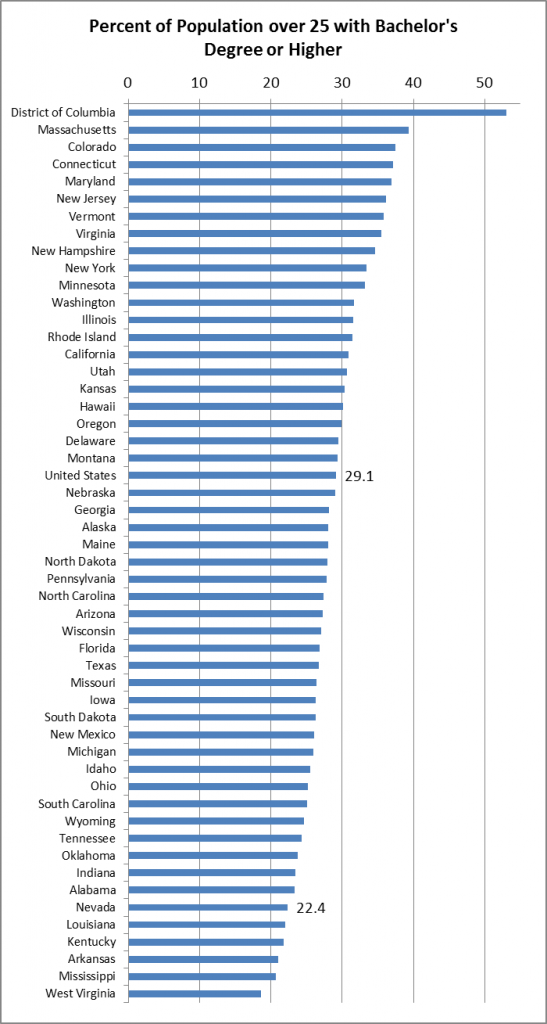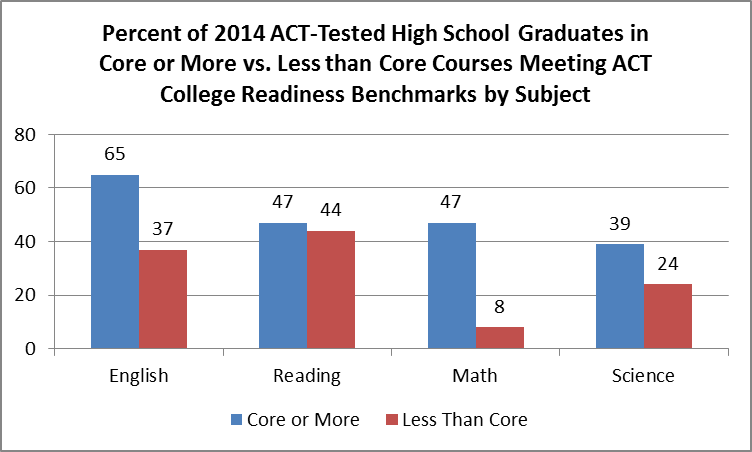Introduction
Nevada ranks 46th in the nation in the percentage of residents with a bachelor’s degree or higher (American Community Survey, 2012). Only 22.4 percent of Nevada’s population age 25 years and older has a bachelor’s degree or higher, compared to the U.S. average of 29.1 percent (see Figure 1). Higher levels of education are associated with higher wages and lower unemployment levels so increasing college attainment could have a significant impact on Nevada’s long-term economic health (Bureau of Labor Statistics).
Figure 1
Source: American Community Survey, 2012
To increase college attainment levels, students need to be prepared to enter college. Data released this week by the ACT provides insight into the college readiness of Nevada’s students. The results illustrate how the courses students choose to take in high school affect their performance on the ACT and their likelihood of success in college. The data also reveals racial disparities in college readiness and shows that some students who aspire to go to college do not ultimately enroll.
The performance of Nevada’s ACT test takers is comparable to the nation’s results. For both Nevada and the nation, 26 percent of test-takers met the ACT College Readiness Benchmarks in all four areas: English, reading, math, and science.
A Minority of Nevada’s Students Currently Take the ACT
ACT estimates that only 36 percent of Nevada’s 2014 graduating class took the ACT, so the findings cannot be generalized to the full student population. However, starting this school year, all 11th grade students will be required to take the ACT as a college and career ready assessment pursuant to AB 288 adopted in the 2013 Legislative Session. For the 2016 graduating class, Nevada’s ACT participation rate should be 100 percent.
High School Curriculum Affects ACT Scores
The ACT reports that 19 percent of Nevada’s test-takers indicated that they did not plan to take a core curriculum consisting of four years of English, and three years each of math, science, and social studies. Figure 2 shows that students who take this core curriculum are more likely to meet the ACT college readiness benchmarks. Research conducted by ACT has shown that students meeting three or four ACT College Readiness Benchmarks are more likely to be successful in postsecondary education.
Figure 2:
Source: ACT
Achievement Gaps Persist for Racial and Ethnic Groups
The ACT data also reveals achievement gaps among Nevada’s students who took the exam. Figure 3 shows the percentage of students meeting the English and math benchmarks by race and ethnicity. Asian and White students had the highest percentage meeting benchmarks in both subjects while African American, American Indian, and Latino students consistently had the lowest percentage meeting benchmarks in both subjects.
Figure 3
Source: ACT
College Aspirations Cut Short for Some Students
A large percentage of ACT-tested graduates indicate that they aspire to attend college but some do not enroll. In 2013, 90 percent of Nevada’s ACT-tested graduates aspired to go to college but only 71 percent enrolled. In 2014, 92 percent of ACT-tested graduates aspire to go to college. Given past trends, not all of these students will likely enroll in post-secondary education.
What can Nevada do to Improve College and Career Readiness?
State and school district policies can help improve college and career readiness. Establishing standards and assessing student performance on the standards are important components of promoting college and career readiness. In the last few years, Nevada has adopted the Nevada Academic Content Standards and the Next Generation Science Standards. In 2013, the state overhauled the high school assessment system to move away from an exit exam to end of course exams through AB 288.
Policymakers should also review graduation requirements and support programs for students that are not on track to graduate. For example, Nevada students currently only need 2 credits each in social studies and science to graduate from high school, while the University of Nevada requires 3 credits in each of these subjects for admission. A comparative chart showing high school graduation requirements and college admission requirements is available from the College and Career Readiness Success Center. Research shows that increasing graduation requirements can increase college enrollment but can also lead to higher dropout rates if students do not receive support services to help them succeed under a more rigorous curriculum.
Improving college and career readiness is critical to Nevada’s economic growth. As Nevada works to diversify its economy through the work of the Governor’s Office of Economic Development, improving college and career readiness of Nevada’s students will help ensure that workers have the 21st Century skills demanded by their employers. Improving college attainment rates will also help increase personal income and reduce unemployment, which will improve the state’s long-term economic health.



